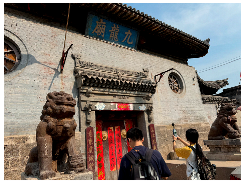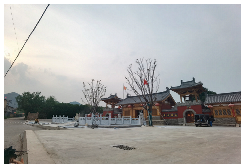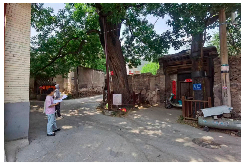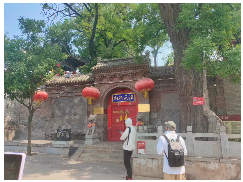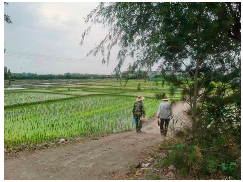Abstract
In response to the growing urban–rural dichotomy and escalating human–land conflicts in rural China, this study investigates the role of soundscapes as emotional mediators to enhance environmental satisfaction and foster sustainable human–land symbiosis. To address this need, we carried out a series of systematic field surveys at five representative traditional villages in a major provincial capital city in China, and we implemented a comprehensive questionnaire and surveyed 524 residents about their perceptions of sound, land affection, and environment. We employed a mixed-methods approach combining questionnaire surveys, association rule mining (ARM), and structural equation modeling (SEM) to explore the ‘sound–land–environment’ interaction chain. ARM analysis identified strong associations among tour guide narratives, local dialects, natural sounds (e.g., rustling leaves, birdsong), and tourist-generated sounds (support = 50%, confidence = 78%, lift = 1.33). SEM results revealed that soundscapes significantly and positively influence land dependence (β = 0.952, p < 0.001) and land rootedness (β = 1.812, p < 0.001), which in turn jointly affect environmental satisfaction (β = –0.192, p = 0.027) through a chain mediation pathway. These findings suggest that optimizing rural soundscapes can strengthen emotional bonds between people and land, thereby enhancing environmental satisfaction and promoting performance of sustainable human–land symbiosis. The study contributes theoretically by elucidating the emotional mechanisms linking soundscapes to human–land relationships and offers insights for incorporating soundscape considerations into village planning and developing policies to cultivate land attachment, supporting the sustainable development of traditional villages.
1. Introduction
Traditional villages are historic settlements that embody rich cultural heritage and distinctive identities. These sites serve as living archives of collective memory, preserving a wealth of historical and cultural landscapes while bearing witness to the enduring legacy of Chinese civilization [1]. Traditional villages are ‘visible history’ and the crystallization of long-term interaction between farming civilization and the natural environment. Their unique topographical layout, village form, and soundscape map out the synergistic symbiotic relationship between humans, land, and ecosystem [2]. As of March 2023, the Ministry of Housing and Urban–Rural Development, the Ministry of Culture and Tourism, and the Ministry of Finance of the People’s Republic of China had successively designated six batches of traditional villages, totaling 8155 (Figure 1).
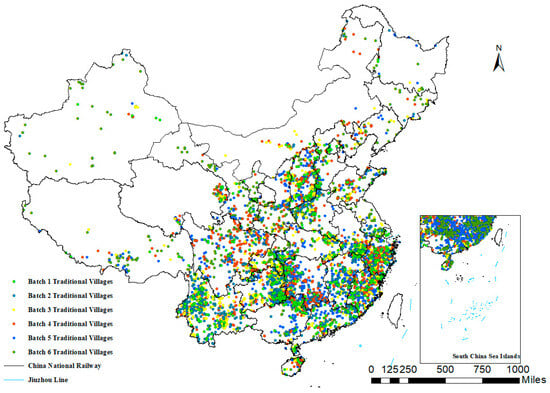
Figure 1.
Spatial distribution of traditional villages across China by batch. Note: The map shows six batches of nationally recognized traditional villages, Batch 1 (green), Batch 2 (light green), Batch 3 (orange), Batch 4 (red), Batch 5 (blue), and Batch 6 (yellow-green).
There is growing concern over the sustainable development of traditional villages, particularly the interaction of the economic, social, and environmental pillars of sustainability. This issue is closely linked to rural revitalization, cultural heritage preservation, and the maintenance of ecological balance in rural areas [3]. With rapid urbanization, traditional villages are confronted with significant challenges. On the one hand, traditional villages possess a wealth of historical memories, local cultures, spatial patterns, and lifestyles, constituting a pivotal domain for preserving place identity and transmitting cultural heritage [4]. On the other hand, with the acceleration of urban expansion and industrialization, traditional villages’ spatial configuration and ecosystem have gradually eroded, resulting in the fracturing of their cultural structure. The original production, ecology, order of life, and land use have been supplanted by the logic of modern planning and the market, giving rise to the common phenomenon of “empty villages, idle land, and people going away” [5]. Moreover, the ongoing process of modernization has had a detrimental effect on the cultural continuity and ecological adaptability of traditional villages. This is evidenced by structural imbalance in the villages’ original production, living, and ecological systems. Such imbalances are manifesting in the following ways: conflict between people and land [6], fragmentation of land resources [7], and decline in the function of ecosystem services [8]. The distinctive folk sounds of villages, such as percussive instruments and music, temple fairs, and dialect conversations, have been progressively diminishing over time [9]. At the social-ecological system level, the evolution of the traditional village space is essentially a dynamic process of reconstructing the ‘ecology–production–life’ [10], space. Under the pressure of resource decline, population loss, and weakening of cultural memory, many traditional villages have entered the vicious circle of “environmental pollution–cultural degradation–land imbalance” [10], and the cultural landscape, ecology, and environment of the villages have been degraded [11], disordered [12], and imbalanced in land use structure [13]. The ecological environment of villages has been damaged, and the contradiction of the human–land relationship has become increasingly prominent [14], which has become the main obstacle constraining the symbiosis of people and land in traditional villages and realizing sustainable development.
The human–land relationship is an intricate and multifaceted system shaped by the dynamic interactions between human activities and the Earth’s environment, and its ultimate goal is to promote the harmonious development of humans and nature [15], to explore the impact of the people–land relationship system with the quantitative characterization of the relationship between human activities and the environment and the coupled influence of factors such as the environment and human beings and the two-way feedback mechanism, and to solve the contradictions between human beings, society, and the environment with the theory of coordinated symbiosis of people–land systems. Multiscale coupling research on human–society–environment systems provides a critical theoretical foundation for achieving the goals proposed at the 20th National Congress of the Communist Party of China (CPC), promoting green development and fostering harmonious coexistence between humanity and nature [16]. The extant literature indicates the presence of a positive emotional relationship between people and the land, as well as between the villagers’ feelings, possession (or nostalgia), and dependence on the land. This phenomenon is referred to as land attachment [17] and has the following selected dimensions: land dependence and land rootedness. Land dependence is the economic and emotional dependence of the villagers on the land, and land rootedness is the villagers’ recognition, concern, and “coming home to where one’s roots lie” feeling.
However, a review of the existing literature revealed a notable knowledge gap in current rural sustainability planning practices. For instance, the role of soundscapes and human–land relationships is often overlooked in rural sustainability planning [18,19]. In particular, local distinctive sounds, such as dialects, ritual music, and natural sounds, have rarely been considered, despite their importance to cultural heritage, living environment, and community identity. Given the above, this study aimed to construct an interactive hinge model to assess the coupling relationship between humans and the acoustic environment and to understand the underlying mechanism. Special emphasis was placed on (1) including a perspective of treating rural soundscapes as emotional mediators that influence land attachment and environmental satisfaction and (2) integrating field surveys with association rule mining (ARM) and structural equation modeling (SEM), based on the theory of stimulus–organism–response (SOR).
Guided by this perspective, the overall goal of this study was to investigate how soundscapes in traditional villages influence land attachment (i.e., land dependence and land rootedness), with the aim of providing theoretical and practical insights into sustainable human–land symbiosis. The specific objectives were to (1) examine the relationships between soundscape perception, land attachment, and environmental satisfaction in prototype traditional villages; (2) identify key soundscape elements that strengthen emotional bonds between human and land; and (3) construct and validate a chain mediation model that explains how soundscapes contribute to sustainable human–land symbiosis. The research framework and procedural steps are shown in Figure 2.
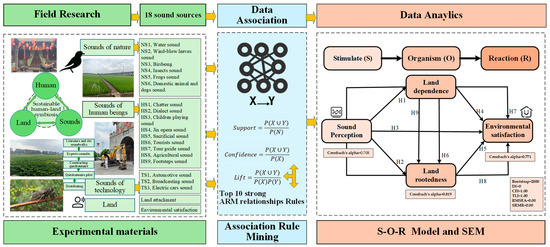
Figure 2.
Research framework and procedural steps of this study. Note: The framework comprises three stages: (1) Field Research, identifying 18 sound sources (from nature, human activities, and technology), 8 land-related items, and 4 environmental satisfaction items through literature review, expert consultation, and surveys; (2) Data Association, using association rule mining (ARM) to detect relationships among sound perception, land attachment, and environmental satisfaction, yielding the top 10 strongest ARM rules; (3) Data Analysis, applying the stimulus–organism–response (S–O–R) model and structural equation modeling (SEM) to test links between sound perception, land dependence, land rootedness, and environmental satisfaction; and (4) Natural sound (NS), human sound (HS), and technology sound (TS) are used as abbreviations, while H1–H9 denote the nine hypothetical paths of SEM.
In summary, our study shows that rural soundscapes not only mirror the cultural and environmental character of traditional villages but also strengthen residents’ emotional bonds with the land. By framing soundscapes as both cultural assets and environmental resources, this study adds to the wider discourse on rural development, environmental psychology, and spatial planning. Recognizing how specific acoustic features nurture land attachment and environmental satisfaction can guide rural revitalization strategies that honor local identity and heritage. For planners and policymakers, integrating soundscape considerations into design and management decisions can improve residents’ quality of life and foster sustainable rural development.
2. Materials and Methods
2.1. Study Area
This paper selected five representative traditional villages in Jinyuan District, Taiyuan City, Shanxi Province (Figure 3): Guchengying Village, Huata Village, Chiqiao Village, Beidasi Village, and Nandasi Village. These villages have a long history, share a similar climate, and grow similar crops such as corn and rice. Table 1 presents key information about the five villages, with a cultivated area ranging from 0.3 to 1.4 km2. It includes the dynasty of origin, cultivated area, and main crops, along with representative photographs of each village.
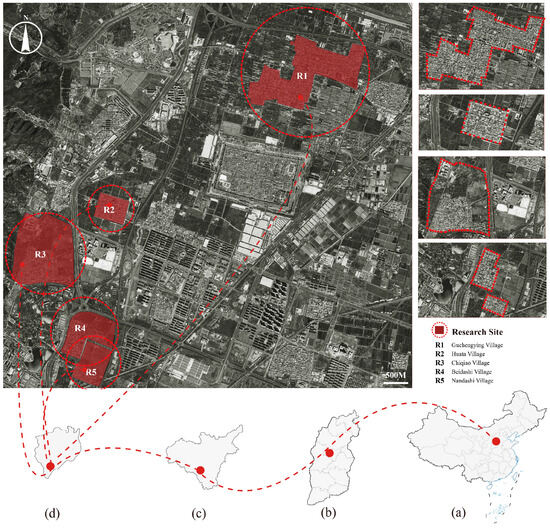
Figure 3.
Locations of the five villages. Note: R1–R5 correspond to Guchengying Village, Huata Village, Chiqiao Village, Beidasi Village, and Nandasi Village, respectively. (a) Location of the study area in China, (b) in Shanxi Province, (c) in Taiyuan City, and (d) in Jinyuan District (source: Google Maps).

Table 1.
Basic information on five villages.
Adjacent to the Taiyuan Ancient County, Guchengying Village (R1) is rich in historical relics, including remains of the ancient capital city of Jinyang, the Temple of the Nine Dragon Kings, a Catholic Church, and the Ashoka Pagoda. The soundscape features both anthropogenic sounds, including those from folk activities, and natural sounds. Huata Village (R2) houses the Huata Temple, a historic structure dating back to 634 AD in the Tang Dynasty, and Guandi Temple, adjacent to the Jinci Museum and Mengshan Buddha, featuring abundant folk activities, with both anthropogenic and natural sounds. Also adjacent to the Jinci Museum, Chiqiao Village (R3) was included in the fifth batch of traditional villages in China, with various folk rituals and a mixture of anthropogenic and natural sounds. Beidashi Village (R4) is one of the eight scenic spots outside the Jinci Museum, where the “Lotus Wind” is located, with the Jieyi Temple and the Wu Ancestral Hall in the village. The soundscape is characterized by anthropogenic sounds interwoven with birds chirping. Adjacent to the Tianlong Mountain, Nandasi Village (R5) is home to the Chongfu Temple, Guanyin Hall, and Jin Ancestral Temple, featuring anthropogenic sounds and natural sounds.
2.2. Survey Design
The initial questionnaire was developed by consulting experts (including engineers, urban planners, architects, psychologists, and sociologists) from Taiyuan University of Technology. The expert opinions were further refined and organized based on established scales and frameworks. To further validate the approach, a preliminary pilot study was carried out at the Guchengying village, where 90 questionnaires were issued randomly and the resulting data were analyzed using SPSS (version 26). The results showed a Cronbach’s α coefficient of 0.750. An exploratory factor analysis yielded a KMO value of 0.823, and a Bartlett’s Test of Sphericity gave a p-value of <0.001, confirming its structural validity.
The questionnaire included four sections: (1) background information: gender, age, occupation, education level, length of residence, proficiency in land farming, etc.; (2) soundscape perception: based on indicators from prior soundscape studies, including measuring preference (PFS), perceived occurrence (POS), and perceived loudness (PLS) for 18 sound sources classified into natural, human, and technological categories [20,21,22] (Table 2), according to the categorization criteria in ISO 12913-2:2018 [20]; (3) land attachment (Table 3): adapted from validated scales [23,24] including eight items covering land dependence and land rootedness; (4) environmental satisfaction (Table 4): four items measuring satisfaction with the soundscape, overall environment, life, and heritage protection. All responses to the questionnaire were based on a five-point Likert scale. Tables S1–S4 in the Supplementary Material also provide a sample of the questionnaire.

Table 2.
Sound perception scale.

Table 3.
Land attachment scale.

Table 4.
Village environment satisfaction scale.
2.3. Sample Selection
Based on the pre-testing results, each student survey was administered 5–10 min after a field measurement. A total of 600 questionnaires were distributed to the five villages on a random basis, of which 524 were collected from the five sites (125 from Guchengying Village, 96 from Huata Village, 117 from Chiqiao Village, 97 from Beidashi Village, and 89 from Nandashi Village), of which 304 or 58% were from males and 220 or 42% from females. The age distribution was 16–60 years old, and the largest age group was 30–60 years old, comprising more than 58% of the respondents. In terms of occupation, a larger portion of participants were farmers or had regular occupations, accounting for 36.6% and 33.6%, respectively. With respect to education level, secondary school participants dominated, accounting for 38.7% of those surveyed, followed by elementary school (35.1%) and university (7.25%). Proficiency in agricultural work skills was more evenly distributed, with the ‘quite good’ accounting for 30.5% (n = 160) and “average” for 26.3%, as shown in Figure 4.
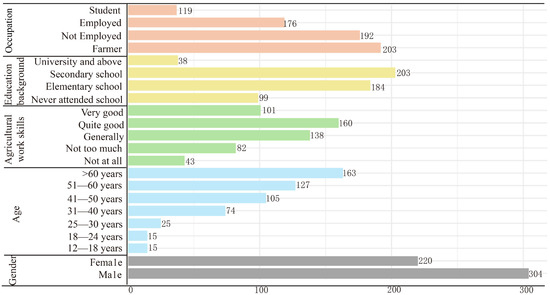
Figure 4.
Sample characteristics of interviewees.
2.4. Soundscape Measurement and Experimental Setup
For each traditional village, 5–10 fixed-point locations were selected according to site-specific conditions (as shown in Figure 5). The measurements were conducted at a height of 1.2 m above the ground using HS6298 multi-function noise analyzers, operated over a frequency range of 20 Hz–12.5 kHz in the fast mode with an A-weighting filter. The measurement campaign was carried out from July 1 through 15, 2024, between 9:00 and 18:00, a period chosen to capture peak daily activity and representative soundscape conditions. At each point, sound levels were recorded three times per day, with each recording lasting for 1 min. Mean LAeq values were then calculated, and major noise sources were documented. The weather conditions during the measurements were generally favorable, with no precipitation, wind speeds below 5 m/s, and occasional cloud cover.
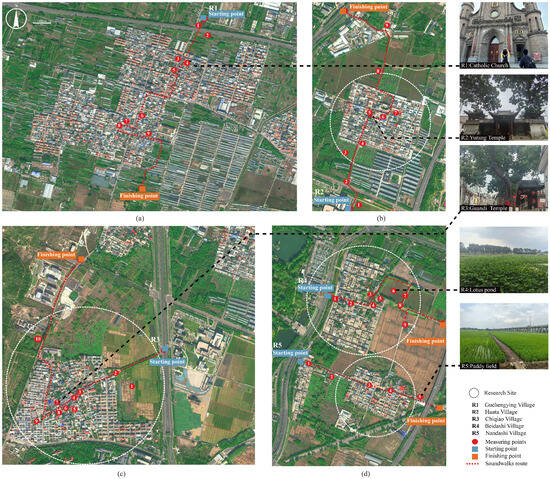
Figure 5.
Measuring points and soundwalk routes in the five study villages. Note: (a) R1 Guchengying Village (Catholic Church), (b) R2 Huata Village (Yurang Temple), (c) R3 Chiqiao Village (Guandi Temple), and (d) R4 Beidasi Village (Lotus Pond) and R5 Nandasi Village (paddy field). Red circles mark measuring points, blue boxes mark starting points, and orange boxes mark finishing points. Dashed red lines indicate soundwalk routes, white dashed circles show measurement areas, and numbers indicate the order of measurement points (satellite imagery source: Google Maps).
Following each measurement, on-site perceptual surveys were administered using a structured questionnaire covering demographic information, sound perception (PFS, POS, PLS), land attachment, and environmental satisfaction. In each village, three main survey locations were chosen: central residential areas, agricultural zones, and public spaces (e.g., markets or cultural sites).
No direct frequency spectra were collected, as the study focused on perceived soundscapes and was constrained by equipment availability and temporal coverage. Instead, subjective perception measures (PFS, POS, PLS) were adopted in accordance with ISO/TS 12913-2:2018 [20] guidelines for soundscape data collection. Sound pressure level (SPL) measurement results are shown in Table 5.

Table 5.
SPL measurement data on working days and non-working days for five villages (R1–R5) as maximum (Max), minimum (Min), and average (Ave) values, in dB(A).
2.5. Methodological Limitations and Considerations
While our study offers new insights into the relationship between rural soundscapes, land attachment, and environmental satisfaction from a human–land symbiosis perspective, the robustness of the findings for different regions, seasons, and cultural contexts may need further validation. In addition, the study relied on self-reported questionnaire data without qualitative triangulation, and the acoustic measurements focused on sound pressure levels without incorporating psychoacoustic characteristics or multisensory interactions that may influence perception. The structural equation model assumed a unidirectional pathway without testing possible reciprocal or moderating effects. Further research is warranted to expand the geographical and temporal scope, include diverse sensory dimensions, and integrate advanced methods such as psychoacoustic analysis, virtual reality simulation, and mixed-methods approaches to enhance model validity and applicability of the findings to broader traditional village contexts.
3. Multilevel Data Analysis
3.1. Association Rule Mining (ARM)
Association rule mining (ARM) is a data mining technique used to uncover interesting relationships, patterns, or associations among variables in large datasets. [25]. Association rule analysis is one of the data mining techniques. Agrawal [26] et al. proposed association rules, which aim to find correlations between different sets of items appearing in the same event. Association rule analysis can explore the complex relationships between clusters of items and environmental factors [27]. The key inference of association rules is that the rules generated need not be interpreted as causality, but rather as association [28]. The aim is that by finding an association between two or more attributes in a dataset, the probability of occurrence of the consequent can be predicted based on the antecedent [29]. Using Apriori in the “arules” package [30] of the open source R software (version 4.4.3) and obtaining the association rule model, the evaluation includes three metrics: support, confidence, and lift. The formula is
(): Number of transactions (survey responses) containing both and .
: Total number of transactions.
This formula represents the proportion of all observations in which both the antecedent and consequent occur together. It represents certain frequently co-occurring sound combinations (e.g., birdsong and dialect) in the villagers’ soundscape perception.
: Number of transactions containing the antecedent .
This formula represents the probability of occurring given that occurs. Here, it indicates how likely a certain sound (e.g., tourist sounds) is perceived when another sound (e.g., tour guide narration) is already perceived.
Support (): Proportion of observations containing .
This formula represents the ratio of the observed co-occurrence to what would be expected if and were independent. A lift greater than 1 suggests a meaningful positive association between the two sounds, beyond random chance.
The “items” in ARM are specific sounds recorded during field surveys (Table 1). Examples include wind-blown leaves, birdsong, local dialects, and tour guide narration. High support and lift values point to sound combinations that form the core of the rural acoustic environment, which is closely linked to villagers’ perceptions. Identifying such sounds helps strengthen emotional ties to the land.
However, ARM may suffer from some drawbacks or pitfalls, such as (1) generation of redundant, trivial, or non-novel rules, especially when certain sound sources occur simultaneously; (2) high sensitivity to the support and confidence thresholds, which may lead to missing important patterns or excessive noises, and (3) limited predictive power in dynamic and noisy environments, such as when villages undergo soundscape shifts with seasons or events. Thus, the rules should be regarded as descriptive patterns rather than reliable forecasts. In this study, we selected sound sources with high theoretical relevance, iteratively refined the support and confidence thresholds, and standardized the data collection conditions.
3.2. Stimulus–Organism–Response Theoretical Model and Research Hypotheses
The stimulus–organism–response (S-O-R) framework, proposed by Mehrabian, Russel [31], and Jacoby [32], explains how external stimuli influence internal psychological states, which in turn shape attitudes or behaviors. Unlike simple cause–effect models, S–O–R emphasizes the role of cognitive appraisal and emotional processing in linking environmental conditions to behavioral outcomes.
Stimulus (S): Acoustic environment of traditional villages, measured by soundscape perception indicators—preference, perceived occurrence, and perceived loudness.
Organism (O): Villagers’ attachment to the land, including land dependence (economic and emotional reliance) and land rootedness (sense of belonging and identity).
Response (R): Environmental satisfaction, based on evaluations of the overall environment, quality of life, and heritage preservation.
Sound is the independent variable, land dependence and land rootedness are the intermediate variables, and village environmental satisfaction is the dependent variable. The hypotheses (Figure 6) are as follows:
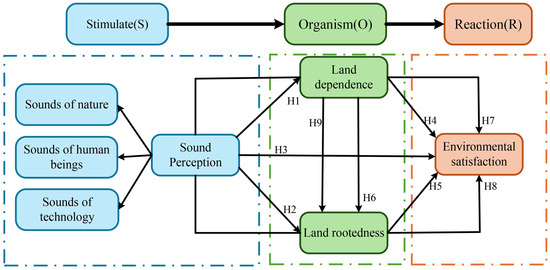
Figure 6.
Meta-model of the sound–land–environment research path under the human–land perspective. Note: The model applies the stimulus–organism–response (S–O–R) framework to hypothesize relationships among three sound categories (nature, human activities, and technology), sound perception, land dependence, land rootedness, and environmental satisfaction. Arrows represent hypothesized paths (H1–H9) between variables.
H1.
Sound perception is a positive predictor of land dependence.
H2.
Sound perception positively predicts land rootedness.
H3.
Sound perception exerts a positive effect on environmental satisfaction.
H4.
Land dependence is a positive predictor of environmental satisfaction.
H5.
Land rootedness positively predicts environmental satisfaction.
H6.
Land dependence exerts a positive effect on land rootedness.
H7.
Land dependence mediates the effect of sound perception and environmental satisfaction.
H8.
Land rootedness mediates the effect of sound perception and environmental satisfaction.
H9.
Land dependence and land rootedness have a chain-mediating effect between sound perception and environmental satisfaction.
3.3. Structural Equation Modeling (SEM) Approach
Based on S–O–R theory, structural equation modeling (SEM) was employed to examine the relationships between sound perception, land attachment, and environmental satisfaction. Reliability and validity tests, as well as exploratory factor analysis (EFA), were conducted in SPSS 26. Confirmatory factor analysis (CFA) was then performed in RStudio (version 4.4.3) using the “lavaan” package [33], with maximum likelihood estimation to assess model fit.
It is noteworthy that SEM may bear with some limitations, such as dependency on theoretical models, sensitivity to missing data, distribution assumptions, and sample size, and some interpretation complexity. To mitigate the potentially relevant uncertainties, we took the following measures:
- (1)
- The theoretical model was grounded on the well-established stimulus–organism–response (S-O-R) framework, which has been extensively validated in environmental psychology and human–land interaction research [34,35];
- (2)
- Before SEM, we conducted an exploratory factor analysis (EFA) to validate the construct structure of land attachment dimensions (land dependence and rootedness).
- (3)
- The model fitting was assessed using multiple indices, including CFI, TLI, and RMSEA. If the MI value is >3.84, it indicates that the path needs to be reworked to improve the model fit; if the MI value shows no output, it means that the current model is saturated and no model correction is required [36].
3.4. Integration of ARM and SEM
The integration of ARM and SEM can help address some of the inherent limitations of each method. ARM, as a data-driven and theory-agnostic approach, is suited for the exploratory identification of potential associations, while SEM, as a theory-driven technique, enables formal testing and validation of these associations within a causal framework. Nevertheless, the transition from exploratory patterns to confirmatory models must remain firmly grounded in theoretical rationale rather than relying solely on data-driven findings. Hence, we mitigated these limitations by refining ARM parameter selection through sensitivity analysis, and testing alternative SEM specifications to ensure model stability with larger datasets would strengthen the robustness and applicability.
4. Results
4.1. ARM Data Analysis and Modeling
To investigate the intrinsic relationships between sound, land, and environment in rural settlements, we performed ARM on questionnaire data collected from villages. As the “Apriori algorithm” requires transactional data formatting [37], the sound perception scales (PFS, POS, PLS) were transformed into transactional datasets through binarization. Specifically, Likert scale responses (1–5) for each sound source were converted to binary values by thresholding: values exceeding the midpoint (mean > 2.5) were encoded as 1, while others were encoded as 0. This process yielded a binary matrix containing 524 observational cases across 16 sound sources, enabling subsequent association rule mining.
The two key parameters for association rule mining are support and confidence. These were set to 0.5 and 0.01, respectively, following a trial-and-error process [38]. Figure 7 shows the results of the analysis of associations between 18 sound sources (water sound, wind-blown leaf sound, birdsong, insect sound, frog sound, chatter sound, dialect sound, children playing sound, Jin opera sound, domestic animal and dog sound, sacrificial sound, tourist sound, tour guide sound, agricultural sound, automotive sound, broadcasting sound, electric car sound, footstep sound) in the sample villages. The color of the nodes indicates lift and support, with darker nodes indicating higher lift and larger nodes indicating higher support.
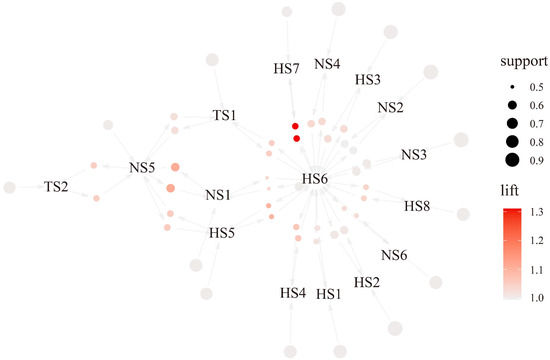
Figure 7.
Visual analysis of soundscape perception using association rule mining (ARM). Note: Nodes represent sound sources (NS, nature sound; HS, human sound; TS, technology sound). Node size reflects support (frequency of occurrence), and node color indicates lift (strength of association), with darker red denoting stronger relationships. Arrows show the direction of association between sound sources.
As illustrated in Table 6, the top 10 strong ARM relationships with the highest degree of lift are filtered out. The results demonstrate that rule 1 {tour guide sound, dialect sound, wind-blown leaf sound, birdsong} => {tourist sound} (“lavaan” representation) exhibits the highest degree of lift. The findings indicate that the predominant sound sources within the village are primarily classified as guide sound, dialect sound, wind-blown leaf sound, bird sound, and tourist sound. These sound sources are employed as the sound source perception variables to perform SEM.

Table 6.
Data analysis of soundscape perception ARM.
4.2. SEM-Based Analysis
4.2.1. Exploratory Factor Analysis (EFA)
Internal consistency of the measurement scales was assessed using Cronbach’s alpha (Table 7). All constructs met the recommended threshold (Cronbach’s α > 0.7) [39], indicating acceptable to good reliability: soundscape perception (α = 0.708), land attachment (α = 0.819), and environmental satisfaction (α = 0.771). This illustrates that the questionnaire scales had good internal consistency and were suitable for further analysis, including EFA and SEM [40].

Table 7.
Internal consistency of the measurement scales.
Because 524 valid responses were obtained and analyzed, we considered that missing data were minimal or handled through imputation (e.g., mean imputation) on the basis that the datasets meet the requirements of factor analyses and SEM.
For the variables of the land attachment questionnaire, principal component analysis and maximum variance method were used for factor extraction and rotation, with the criteria of variance of public factors greater than 0.4, eigenvalue greater than 1, and loading coefficient greater than 0.5, and finally, two public factors were extracted with a total explanation of 57.65%. The extracted factors are acceptable if the cumulative variance explained after extraction is 50% or more [41]. The factors were categorized as land dependence and land rootedness (see Table 8).

Table 8.
Component matrix after rotation of land attachment scale.
4.2.2. Confirmatory Factor Analysis (CFA)
Assuming that village sound, land dependence, and land rootedness affect village satisfaction, an SEM model of the village “sound perception–land attachment–environmental satisfaction” was constructed by taking sound perception, satisfaction evaluation, land dependence, and land rootedness as potential variables. The “Lavaan” package in RStudio software 3.6.0+ was used to validate the factor analysis, the maximum likelihood estimation method was used for parameter estimation, and the values of parameters such as p-value (Chi-square), goodness-of-fit index (GFI), comparative fit index (CFI), and root mean square error of approximation (RMSEA) were used as references to judge the validity of the model.
A bootstrap test (2000 samples, 95% confidence interval) was conducted to evaluate mediation paths and ensure robustness of indirect effects, addressing potential non-normality in SEM [42]. The final chain-mediated model (df = 0, CFI = 1.00, TLI = 1.00, RMSEA = 0.00, SRMR = 0.00) required no modification (Table 9), as indicated by an empty modification index (MI) table, confirming both theoretical and statistical soundness [43].

Table 9.
Goodness-of-fit indices used.
4.3. Linkage Analysis
The pathways and path coefficients shown in the results of the multiple-chain mediation model are shown in Figure 8 and Table 10. Equations were created using sound perception and land dependence as independent variables and environmental satisfaction as the dependent variable. The results show that sound perception has a significant positive effect on land dependence (H1: β = 0.952, SE = 0.017, p < 0.001); Land dependence has a significant positive influence on environmental satisfaction (H4: β = 0.491, SE = 0.130, p < 0.001); In addition, sound perception had a positive impact on village environmental satisfaction by facilitating the land dependence complex, which in turn had a positive effect on village environmental satisfaction (H7: β = 0.467, SE = 0.125, p < 0.001, 95% CI [0.229, 0.712]). This shows that land dependence has a significant positive mediating effect between soundscape perception and satisfaction. The higher the evaluation of village soundscape perception, the stronger the land dependence complex, and the higher the environmental satisfaction evaluation of the village. This means that hypotheses H1, H4, and H7 are valid.
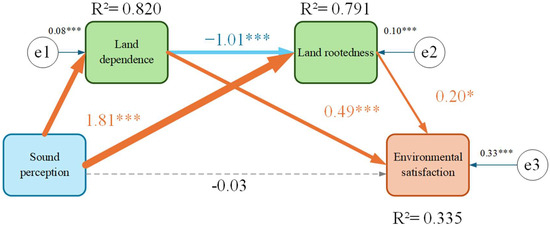
Figure 8.
Hinge diagram of the “soundscape perception–land attachment–environmental satisfaction” cycle. Note: Arrows represent standardized path coefficients, with thickness proportional to effect size. Solid orange paths indicate significant positive effects; solid blue paths indicate significant negative effects; dashed lines indicate non-significant paths. R2 values show the variance explained for each latent variable. *** p < 0.001, * p < 0.05.

Table 10.
Model standardized path coefficients for “soundscape perception–land attachment–environmental satisfaction”.
Equations were formulated with sound perception and land rootedness as independent variables and environmental satisfaction as a dependent variable. The results obtained demonstrated that sound perception exerts a significant positive effect on land rootedness (H2: β = 1.812, SE = 0.057, p < 0.001). The hypothesis that land rootedness exerts a significant positive effect on environmental satisfaction was substantiated (H5: β = 0.200, SE = 0.088, p = 0.023). Concurrently, the concept of land rootedness emerged as a pivotal mediator between soundscape perception and environmental satisfaction (H8: β = 0.362, SE = 0.162, p = 0.025, 95% CI [0.049, 0.690]). This means that H2, H5, and H8 hold.
In addition, sound perception, land dependence, and land rootedness were used as independent variables, and environmental satisfaction was used as the dependent variable to construct equations. The hypothesis that sound perception exerts a significant effect on environmental satisfaction scores was not supported by the data (H3: β = −0.031, SE = 0.193, p = 0.874). While land dependence had a significant negative impact on land rootedness (H6: β = −1.012, SE = 0.056, p < 0.001), sound perception has a significant effect on village environmental satisfaction through the chain mediation of land dependence and land rootedness (H9: β = −0.192, SE = 0.087, p = 0.027, 95% CI [−0.370, −0.025]). This means that hypothesis H9 is valid, but H3 and H6 are not.
5. Discussion
5.1. Direct Effects of Sound Perception on Land Attachment
After the results of the association rule model were analyzed, a strong correlation was found between tour guides, tourists, wind-blown leaves, birdsong, and dialects (support = 50%, confidence = 78%, lift = 1.33). The results showed a preference for birdsong and wind-blown leaves among nature sounds and for tour guides, tourists, and dialects among life sounds. However, mechanical sounds were not favored due to negative emotions regarding satisfaction with the environment at the time. Structural equation modeling revealed a direct and positive correlation between sound perception and land attachment and a positive correlation between land dependence (H1: β = 0.952, SE = 0.017, p < 0.001) and land rootedness (H2: β = 1.812, SE = 0.057, p < 0.001).
Our findings confirm existing findings that emotional attachment to land is a key factor influencing rural environmental satisfaction [23,44]. They also expand on previous work by introducing soundscape perception as a meaningful environmental stimulus that shapes land attachment, through culturally familiar sounds such as dialects and local narratives [45]. While prior studies have acknowledged the negative impact of mechanical noise on well-being [46], our research integrates these auditory perceptions into a broader emotional–cognitive framework. Notably, the study challenges the assumption that sound influences satisfaction, revealing instead that its effect is largely indirect, operating through emotional connections to the land. This nuance adds depth to existing models in environmental psychology and emotional geography, offering new insights into the mechanisms driving human–land relationships in traditional rural settings.
5.2. Mediating Role of Land Attachment
In the SEM, land dependence and land rootedness each showed positive correlations with village environmental satisfaction evaluation (H4: β = 0.491, SE = 0.130, p <0.001, H5: β = 0.200, SE = 0.088, p = 0.023), and the contribution of the mediating effect of land dependence was larger compared to the two. Meanwhile, sound perception influenced village environmental satisfaction evaluation through the chain effect of land dependence and land rootedness (H9: β = −0.192, E = 0.087, p = 0.027, 95% CI [−0.370, −0.025]). As individuals with stronger perceptions of village sound are more positively affected by the village environment, this increases land dependence sentiment, which in turn generates land rootedness, resulting in higher satisfaction ratings with the village environment. At the same time, land dependence has a significant negative effect on land rootedness (H6: β = −1.012, SE = 0.056, p < 0.001); it generates the ambivalent emotion of being willing to give up the land but having land attachment. Similarly, studies by Xu et al. [24] and Xiang et al. [47] highlighted the importance of land attachment, especially land rootedness, in shaping how rural residents perceive and value their environment. To some extent, our work provides empirical evidence for a sound–land–satisfaction pathway. It shows that soundscape perception strengthens emotional bonds with the land, which in turn leads to greater satisfaction with the rural environment.
The findings are consistent with the report by Li in 2023 [45], emphasizing the concept of audible nostalgia, where familiar cultural sounds, such as local dialects and tour guide narratives, strengthen emotional ties to the land. This aligns with our observation that culturally significant sounds enhance environmental satisfaction through deepening land attachment.
6. Concluding Remarks
This study explored the relationship between soundscape perception, land attachment, and environmental satisfaction in prototype Chinese traditional villages. The main findings are summarized as follows:
- (1)
- Using a mixed-methods approach combining ARM and SEM, we identified key sound sources, such as dialects, tour guide speech, and natural sounds, which are strongly associated with positive emotional responses.
- (2)
- Soundscape perception significantly enhances both land dependence and land rootedness. These emotional bonds, in turn, have a positive impact on villagers’ satisfaction with their environment. Notably, sound does not directly influence environmental satisfaction; instead, it operates through a chain of emotional mediators. This finding highlights the importance of emotional geography and cultural soundscapes in shaping human–land relationships.
- (3)
- By integrating auditory perception into the study of rural sustainability, this work offers a new framework for understanding and strengthening human–land symbiosis. It also provides practical insights for village planning, suggesting that optimizing sound environments and reinforcing land attachment can support the sustainable development of traditional settlements.
This study reveals the mechanism by which village soundscape perception acts on environmental satisfaction from a human–land perspective and constructs a “sound–land–environment” chain mediation effect model. Theoretically, this work proposed and validated a sound–land–emotion model and framework for studying human–land symbiosis, and it offers a new lens for sustainable rural planning that integrates sensory experience with emotional geography. Methodologically, it innovatively integrates association rule mining (ARM) and structural equation modeling (SEM) to construct an interdisciplinary multi-source data fusion analysis model, which strengthens the explanatory power and predictive effectiveness of research on human–land systems in villages.
It is noted that the current analysis focused primarily on the presence or absence of certain sounds and general appreciation of the environment, without delving into the specific ways these sounds contribute to the sonic identity of each village. From an anthropological perspective, such sounds act as cultural markers, evoke collective memories, and sustain social and ritual practices, thereby reinforcing emotional bonds with the land. Consequently, the data may not fully reflect the real village acoustic environment and on-site life scenes. Further studies are warranted to combine open-ended questionnaires with recorded sound samples to reveal how these soundscapes shape a sense of place and belonging, including the use of advanced methods such as audiovisual interaction, immersive virtual reality (VR), and physiological response monitoring. In addition, follow-on studies will aim to expand the geographic scope and diversity by targeting traditional villages of different sizes and diverse cultural, economic, and environmental backgrounds, providing deeper insight into how they mediate human–land relationships.
The findings offer valuable guidance for rural planners and policymakers. Optimizing rural soundscapes can strengthen villagers’ emotional connection to the land. This includes preserving natural sounds such as birdsong and wind. It also involves promoting culturally meaningful human sounds, like local dialects and traditional performances. This emotional connection, in turn, enhances satisfaction with the living environment and supports long-term community stability. Rural planning should also avoid intensive mechanical or intrusive sounds (e.g., traffic and loudspeakers).
Future research may expand in the following directions:
- (1)
- Application of soundscape design in village renewal programs. For instance, local dialects, traditional performances, and natural sounds may be incorporated into rural planning and revitalization strategies to strengthen land attachment and cultural identity.
- (2)
- Longitudinal tracking of emotional bond evolution. Long-term studies are needed to observe how villagers’ emotional connections to land evolve over time, particularly in response to changes in acoustic environments, policies, or land use.
- (3)
- Incorporation of objective acoustic measurements. We should combine subjective perceptions with objective acoustic data (e.g., decibel levels, video, frequency spectra, etc.) to improve the precision and replicability of soundscape assessments in rural settings.
Supplementary Materials
The following supporting information can be downloaded at: https://www.mdpi.com/article/10.3390/land14081676/s1, Section S1: The Questionnaire on sound perception and land attachment in traditional villages; Table S1: Questionnaire information of all respondent villages; Table S2: Sound perception scale; Table S3: Village environment satisfaction scale; Table S4: Land attachment scale.
Author Contributions
Conceptualization, J.W.; methodology, J.W.; software, J.W.; validation, J.W.; formal analysis, J.W.; investigation, J.W.; resources, X.W.; data curation, J.W.; writing—original draft preparation, J.W.; writing—review and editing, X.W. and J.W.; investigation, J.W., S.Z., and Z.Z.; supervision, X.W. and D.Z.; project administration, X.W.; funding acquisition, X.W. and D.Z. All authors have read and agreed to the published version of the manuscript.
Funding
This research was supported by the Major Decision-Making Consulting Project of the Shanxi Provincial People’s Government (Grant No. ZB3801), the Shanxi Provincial Basic Research Program (Free Exploration Category, Grant No. 20210302124119), the Rural Revitalization Strategy Research Project of Shanxi Province (Grant No. 202321−07), and startup funds from San Diego State University.
Data Availability Statement
The original contributions presented in this study are included in the article; further inquiries can be directed to the corresponding authors.
Conflicts of Interest
The authors declare no conflicts of interest.
References
- Li, J.; Wang, X.; Li, X. Spatial Distribution Characteristics and Influencing Factors of Chinese Traditional Villages. Econ. Geogr. 2020, 40, 143–153. [Google Scholar] [CrossRef]
- Li, Y. Traditional Resources in the Reconstruction of the Contemporary Chinese Rural Community: The Huizhou Village as an Example. Soc. Sci. China 2008, 29, 193–200. [Google Scholar] [CrossRef]
- Mei, S.J.; Rahmanita, M.; Mumin, A.T.; Trisakti Institute of Tourism. Traditional Village Development Strategies for Sustainable Tourism (Case Study of Leshan Fishing Village, China). J. Econ. Financ. Manag. Stud. 2024, 7, 5779–5789. [Google Scholar] [CrossRef]
- Chen, C.; Li, B.; Yuan, J.; Yu, W. Spatial Morphology Cognition of Traditional Village Based on Space Syntax: A Case Study of Qinchuan Village of Hangzhou. Econ. Geogr. 2018, 38, 234–240. [Google Scholar] [CrossRef]
- Ma, L.; Zhang, W.; Wang, X.; Chen, X.; Bai, J. Theoretical Model of Symbiosis between Rural Settlements and Cultivated Land and Scenarios Simulation in Case Area. Acta Geogr. Sin. 2024, 79, 1265–1285. [Google Scholar]
- Zhou, Z.; Tan, L.; Qu, L.; Li, Y.; Chen, X. The Impact of Rural Land Transfer on the Living Satisfaction of Middle-Aged Rural Residents and the Implications: A Perspective of Land Attachment. Habitat Int. 2024, 148, 103085. [Google Scholar] [CrossRef]
- Wang, J.; Peng, P.; Liu, T.; Wang, J.; Zhang, S.; Niu, P. Revealing the Spatiotemporal Changes in Land Use and Landscape Patterns and Their Effects on Ecosystem Services: A Case Study in the Western Sichuan Urban Agglomeration, China. Land 2025, 14, 1012. [Google Scholar] [CrossRef]
- Zheng, X.; Wu, J.; Deng, H. Spatial Distribution and Land Use of Traditional Villages in Southwest China. Sustainability 2021, 13, 6326. [Google Scholar] [CrossRef]
- Mao, L.; Zhang, X.; Ma, J.; Jia, Y. Cultural Relationship between Rural Soundscape and Space in Hmong Villages in Guizhou. Heliyon 2022, 8, e11641. [Google Scholar] [CrossRef]
- Shao, Y.; Cui, J. Space and Landscape Evolution Mechanism and Resource Governance Characteristics of Traditional Villages from the Perspective of Social-Ecological System. Landsc. Archit. 2024, 31, 115–124. [Google Scholar] [CrossRef]
- Liu, S.; Wu, L.; Xiang, C.; Dai, W. Revitalizing Rural Landscapes: Applying Cultural Landscape Gene Theory for Sustainable Spatial Planning in Linpu Village. Buildings 2024, 14, 2396. [Google Scholar] [CrossRef]
- Watts, G.R.; Pheasant, R.J. Factors Affecting Tranquillity in the Countryside. Appl. Acoust. 2013, 74, 1094–1103. [Google Scholar] [CrossRef]
- Xiao, J.; Dai, J.; Chen, L.; Song, Y. The Identification of Land Use Conflicts and Policy Implications for Donghai County Based on the “Production–Living–Ecological” Functions. Land 2024, 13, 2013. [Google Scholar] [CrossRef]
- Xu, C.; Lyu, C.; Chen, Z.; Guo, Y. The Spatial Pattern and Influencing Factors of Cultivated Land Natural Quality from the Perspective of Province. Chin. J. Agric. Resour. Reg. Plan. 2022, 43, 253–264. [Google Scholar]
- Ge, Q.; Fang, C.; Jiang, D. Geographical Missions and Coupling Ways between Human and Nature for the Beautiful China Initiative. Acta Geogr. Sin. 2020, 75, 1109–1119. [Google Scholar]
- The Outline of the 14th Five-Year Plan for National Economic and Social Development of the People’s Republic of China and the Long-Range Objectives Through the Year 2035. Available online: https://www.gov.cn/xinwen/2021-03/13/content_5592681.htm (accessed on 18 June 2024).
- Liu, G.; Ma, Z.; Guo, S.; Deng, X.; Song, J.; Xu, D. How Does Farmers’ Differentiation Affect Farmland Abandonment from the Perspective of Land Attachment and Generational Differences? Evidence from Sichuan Province, China. Environ. Dev. 2023, 48, 100924. [Google Scholar] [CrossRef]
- Waitt, G.; Duffy, M. Listening and Tourism Studies. Ann. Touris. Res. 2010, 37, 457–477. [Google Scholar] [CrossRef]
- Ren, X.; Li, Y.; Luo, G.; Huang, J.; Zhang, Y.; Xu, Q.; Yang, L. The Rural Human-Land Relationship Transition in Southwest Karst Mountainous Areas Based on Rural Population, Agricultural Production Land, and Rural Settlement Coupling. Habitat Int. 2025, 163, 103493. [Google Scholar] [CrossRef]
- ISO/TS 12913-2:2018; Acoustics—Soundscape—Part 2: Data Collection and Reporting Requirements. Organization for Standardization: Geneva, Switzerland, 2018.
- Liu, J.; Yang, L.; Xiong, Y.; Yang, Y. Effects of Soundscape Perception on Visiting Experience in a Renovated Historical Block. Build. Environ. 2019, 165, 106375. [Google Scholar] [CrossRef]
- Yang, L.; Liu, J.; Albert, C.; Guo, X. Exploring the Effects of Soundscape Perception on Place Attachment: A Comparative Study of Residents and Tourists. Appl. Acoust. 2024, 222, 110048. [Google Scholar] [CrossRef]
- Xu, G.; Huang, X.; Zhou, Y.; Xu, Y.; Li, J. Literature Review on Land Attachment. Mod. Urban Res. 2017, 10, 2–6. [Google Scholar]
- Xu, G.; Li, Y.; Hay, I.; Zou, X.; Tu, X.; Wang, B. Beyond Place Attachment: Land Attachment of Resettled Farmers in Jiangsu, China. Sustainability 2019, 11, 420. [Google Scholar] [CrossRef]
- Sumathy, K.L.; Chidambaram, M. Text Mining: Concepts, Applications, Tools and Issues an Overview. Int. J. Comput. Appl. 2013, 80, 29–32. [Google Scholar] [CrossRef]
- Agrawal, R.; Imieliński, T.; Swami, A. Mining Association Rules between Sets of Items in Large Databases | Proceedings of the 1993 ACM SIGMOD International Conference on Management of Data. Sigmod Rec. 1993, 207–216. [Google Scholar] [CrossRef]
- Kim, G.-H.; Kim, T.-H.; Hong, J.-Y. Exploring Associations between Urban Soundscape and Contextual Factors Based on a Textual Data-Driven Analysis and Mapping Approach: A Case Study in Daejeon, Korea. Appl. Acoust. 2025, 228, 110319. [Google Scholar] [CrossRef]
- Kong, X.; Das, S.; Jha, K.; Zhang, Y. Understanding Speeding Behavior from Naturalistic Driving Data: Applying Classification Based Association Rule Mining. Accid. Anal. Prev. 2020, 144, 105620. [Google Scholar] [CrossRef]
- Li, X.-y.; Xu, J.-y.; Zhou, Y. Factors Influencing Depression in Middle-Aged and Elderly Individuals and Mining of Association Rules. Mod. Prev. Med. 2024, 51, 4349–4354. [Google Scholar] [CrossRef]
- Hahsler, M.; Chelluboina, S.; Hornik, K.; Buchta, C. The Arules R-Package Ecosystem: Analyzing Interesting Patterns from Large Transaction Data Sets. J. Mach. Learn. Res. 2011, 12, 2021–2025. [Google Scholar]
- Mehrabian, A.; Russell, J.A. An Approach to Environmental Psychology; MIT Press: Cambridge, MA, USA, 1974. [Google Scholar]
- Jacoby, J. Stimulus-Organism-Response Reconsidered: An Evolutionary Step in Modeling (Consumer) Behavior. J. Consum. Psychol. 2002, 12, 51–57. [Google Scholar] [CrossRef]
- Rosseel, Y. Lavaan: An R Package for Structural Equation Modeling. J. Stat. Softw. 2012, 48, 1–36. [Google Scholar] [CrossRef]
- Zhu, N.; Xu, H.; Zhang, X.; Chen, L. A Study on the Influence of Rural Tourism’s Perceived Destination Restorative Qualities on Loyalty Based on SOR Model. Front. Psychol. 2025, 16, 1529686. [Google Scholar] [CrossRef] [PubMed]
- Zou, T.; Guan, J.; Wang, Y.; Zheng, F.; Lin, Y.; Zhao, Y. Research on the Thermal Comfort Experience of Metro Passengers Under Sustainable Transportation: Theory of Stimulus-Organism-Response Integration with a Technology Acceptance Model. Sustainability 2025, 17, 362. [Google Scholar] [CrossRef]
- Bagozzi, R.P.; Yi, Y. On the Evaluation of Structural Equation Models. J. Acad. Mark. Sci. 1988, 16, 74–94. [Google Scholar] [CrossRef]
- Zhang, Y.; Huang, H. Unraveling How Poor Logistics Service Quality of Cross-Border E-Commerce Influences Customer Complaints Based on Text Mining and Association Analysis. J. Retail. Consum. Serv. 2025, 84, 104237. [Google Scholar] [CrossRef]
- Chen, S.; Yuan, Y.; Luo, X.; Jian, J.; Wang, Y. Discovering Group-Based Transnational Cyber Fraud Actives: A Polymethodological View. Comput. Secur. 2021, 104, 102217. [Google Scholar] [CrossRef]
- Watson, D.; Clark, L.A.; Tellegen, A. Development and Validation of Brief Measures of Positive and Negative Affect: The PANAS Scales. J. Pers. Soc. Psychol. 1988, 54, 1063–1070. [Google Scholar] [CrossRef] [PubMed]
- Wu, Y.; Cui, J.; Huang, J.; Zhang, W.; Yoshimoto, N.; Wen, L. Correlation of Critical State Strength Properties with Particle Shape and Surface Fractal Dimension of Clinker Ash. Int. J. Geomech. 2021, 21, 04021071. [Google Scholar] [CrossRef]
- Wu, M. Questionnaire Statistical Analysis Practice: SPSS Operation and Application; Chongqing University Press: Chongqing, China, 2010. [Google Scholar]
- Hu, L.; Bentler, P.M. Cutoff Criteria for Fit Indexes in Covariance Structure Analysis: Conventional Criteria versus New Alternatives. Struct. Equ. Model. Multidiscip. J. 1999, 6, 1–55. [Google Scholar] [CrossRef]
- Steeger, C.M.; Gondoli, D.M. Mother-Adolescent Conflict as a Mediator between Adolescent Problem Behaviors and Maternal Psychological Control. Dev. Psychol. 2013, 49, 804–814. [Google Scholar] [CrossRef]
- Yang, H.; Zhang, S. Impact of Rural Soundscape on Environmental Restoration: An Empirical Study Based on the Taohuayuan Scenic Area in Changde, China. PLoS ONE 2024, 19, e0300328. [Google Scholar] [CrossRef]
- Li, Z.; Li, J. Audible Nostalgia:Soundscapes in Rural Tourism. J. Sichuan Norm. Univ. 2023, 50, 98–106. [Google Scholar] [CrossRef]
- Jo, H.I.; Jeon, J.Y. Urban Soundscape Categorization Based on Individual Recognition, Perception, and Assessment of Sound Environments. Landsc. Urban Plan. 2021, 216, 104241. [Google Scholar] [CrossRef]
- Xiang, X.; Xiao, Y.; Feng, Q.; Wang, R.; Huang, H. Relationship among Residential Satisfaction, Social Ties, Place Attachment and Perceived Disaster Risk in the off-Site Reconstruction Area—Evidence from an Earthquake-Stricken County in Southwestern China. Int. J. Disaster Risk Reduct. 2024, 111, 104741. [Google Scholar] [CrossRef]
Disclaimer/Publisher’s Note: The statements, opinions and data contained in all publications are solely those of the individual author(s) and contributor(s) and not of MDPI and/or the editor(s). MDPI and/or the editor(s) disclaim responsibility for any injury to people or property resulting from any ideas, methods, instructions or products referred to in the content. |
© 2025 by the authors. Licensee MDPI, Basel, Switzerland. This article is an open access article distributed under the terms and conditions of the Creative Commons Attribution (CC BY) license (https://creativecommons.org/licenses/by/4.0/).
